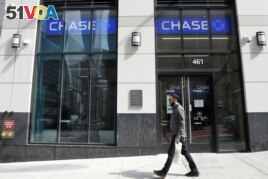02 May 2021
Several American banks have started using surveillance software and computer vision to watch people using their services. Computer vision is a part of artificial intelligence that uses computers to understand the world we see.
A Reuters news agency investigation found that the software is used to learn about customers, watch employees and spot people sleeping near Automatic Teller Machines (ATMs).
Banks like the City National Bank of Florida and JPMorgan Chase & Co have tested facial recognition and artificial intelligence (AI) technologies. The growth of AI tools within the banking industry could signal the spread of the technology into other industries.
Bobby Dominguez is the chief information security officer at City National Bank. He said smartphones that open through facial recognition have shown the potential of the technology.
"We're already leveraging facial recognition on mobile," he said. "Why not leverage it in the real world?"
Dominguez said City National will begin testing facial recognition next year to identify customers and employees. He added the software could find people on government watch lists.
Facial recognition technology, however, has raised civil rights concerns among many people. Critics of the tool point to arrests of innocent people wrongly identified by the technology. The software is said to be used disproportionately in poorer and minority communities. Critics also say the technology results in a loss of privacy.
This year, Portland, Oregon, banned businesses from using facial recognition in public places. The drugstore company Rite Aid also closed a facial recognition program last year.
Fredrik Nilsson is the vice president at Axis Communications, which makes surveillance cameras. He said a big question for banks with this technology is how the public will react to it.
Dominguez said he and other bank officials had thought about customers' concerns.
"We're never going to compromise our clients' privacy," Dominguez said.

Cameras are seen on the exterior of a Chase Bank branch in New York City U.S., April 7, 2021. REUTERS/Brendan McDermid/File Photo
Watching workers and customers
The largest American bank, JPMorgan, began using surveillance technology in 2019. Former employees said the bank researched videos and photos to learn more about their customers.
Video showed that more men would visit the bank before or after lunch. Women would come in the middle of the afternoon. Before the pandemic, the company was going to use the footage to see whether women avoided contact with others while using ATMs. JPMorgan said it uses the data to better plan work hours for employees and to design its banks.
A current employee said the bank could soon test facial recognition software on people as they enter a bank. People would need to agree to be a part of the test, however.
JPMorgan is using software that aims to measure how employees spend their time. Others seek to identify how many customers leave because of long lines and to find out how long transactions take.
The bank also said that facial, race and gender recognition are not part of the test.
Targeting homeless people
Banks have wanted to use computer vision for security for a long time. More than 10 years ago, Wells Fargo used old software to study video of crimes to see if any faces matched known criminals.
An official at a bank in America's South said that computer vision is being used at all of his company's banks. It creates warnings when doors to safes or other important rooms are left open.
Outside, the bank watches for people loitering. Some homeless people set up shelters underneath covered ATMs. Security workers can play a sound message asking those people to leave, the official said.
Brian Karas works at Airship Industries, which creates computer vision software. He said that banks have long been concerned with people sleeping in ATM spaces where people use machines to do their banking business.
Some software can sound an alarm or shine a bright light when cameras see a person loitering, Karas said. He added that the companies did not want to displace people seeking shelter, but that the company believed it was necessary to make ATMs safe and available.
Bank of America, the country's second largest bank, has also invested in computer vision. At a September 2019 conference with the bank, the company AnyVision explained how it could identify the face of a Bank of America official.
The bank said, "We are always reviewing potential new technology solutions that are on the market."
I'm Dan Friedell.
Paresh Dave and Jeffrey Dastin reported this story for Reuters. Dan Novak adapted it for VOA Learning English. Mario Ritter, Jr. was the editor.
____________________________________________________________
Words in This Story
surveillance-n. the act of carefully watching someone or something especially in order to prevent or detect a crime
vision-n. the ability to see : sight or eyesight
potential-n. a quality that something has that can be developed to make it better
leverage–n. influence or power used to achieve a desired result
disproportionate-adj. having or showing a difference that is not fair, reasonable, or expected ; too large or too small in relation to something
privacy-n. the state of being alone : the state of being away from other people
transaction-n. the act or process of doing business with another person, company, etc.
loiter-v. to remain in an area when you do not have a particular reason to be there